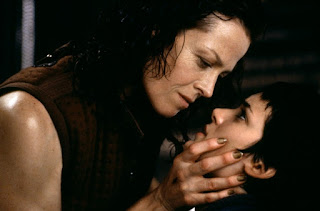The plot of The Ruins (2008) is charmingly simple. We meet a group of young American tourists at a Mexican resort. We spend some time with them, getting a vague idea of their personalities, and then we follow them on an "adventure" to an ancient Mayan ruin they've heard about that, of course, is not on the maps. Traveling with them are a German tourist looking for his brother, and a Greek tourist looking for a good time. They arrive at the temple, and are immediately surrounded by natives who speak neither Spanish or English. These natives will not allow the young people to leave the ruins, though nobody can figure out why. When their Greek traveling companion tries to confront their captors, he is shot in the face.
And so they are trapped on top of this vine covered ruin. In the novel, this is a problem in itself. They don't have much food or water, and they are out in the hot sun. But the movie glosses over this and moves right along to the weird stuff. The vines. We see the faintest hints of the vines moving in these first scenes of them exploring the ruins. We see slight shifts in shadow, and at the edges of the screen. It's subtle in a way that I wasn't expecting. It's also an effective way to build tension. We're watching them explore, knowing that they aren't seeing everything.
But when the tension is broken, it's not because of the strange moving vines. The group is lowering the German into the ruins in the hopes that he can find his brother's satellite phone. They've heard it ringing several times now, and it is their only real hope of getting help. The rope snaps, though, and the German becomes paralyzed from the fall. When one of the girls goes down to rescue him, she falls too, badly gouging her knee. This specific detail becomes important later. Eventually they find a way to get everyone out of the hole. This involves a lot of visceral broken back sounds, and is a pretty good argument for not moving someone with a spinal injury.
The next morning when the girl with the gouged knee wakes up, a vine has snaked around her leg and into the open wound. It has worked its way deep into the flesh of her leg, and it does not come out easily. Outside the tent, the paralyzed German starts screaming about something being wrong. His legs are wrapped in the vines too, though they've been doing much more damage there. The bones are visible beneath the exposed red flesh and the green twisting vegetation.
I was waiting for the vines to attack someone, to lunge out and grab one of them and pull them away like a monster. But this was so much more effective. The plants attacking gradually through the night, being drawn to blood. It feels so much more plausible, not so different from a venus fly trap.
So, they're trapped on a ruin in the burning sun, surrounded by armed Mayans and flesh eating vines. It suddenly starts to seem worth the risk to go back down into that hole to find the satellite phone that keeps ringing. They go down into the dark, following the sound deeper into the ruins. It stops as they enter a large chamber, and they discover a body wrapped in vines, clutching a cell phone.
But on closer examination, the cell phone is broken. And, while one character is pointing this out, the ringing starts up again. The other girl lifts her torch to look closer at the wall where the sound is coming from, and she sees the small red flowers of the vine. The ringing comes again, and the realization that the flowers are imitating the sound is amazing. So creepy. Such a perfect and simple lure, imitating animal sounds.
Unfortunately, the movie goes on to have the vines be more and more sentient, imitating certain sounds in order to play with their minds? How do plants know about jealousy? And now they really are lunging out to attack them. Suddenly they are like any other B-movie grade monster.
Still, even though the plant itself becomes less plausible, the film still uses it sparingly, instead focusing on the characters and their failed attempts to cope with this insane situation. Most of the horrific scenes in this movie come from watching things the characters do to themselves out of panic. The girl with vines in her body goes bonkers and tries to cut them out with a hunting knife. It is gory and awful and so completely understandable. I would not be able to handle having something moving under my skin like that. "I can feel it down by the bone," she says. Ugh!
The things that The Ruins does really well are surprising and intelligent, while the things it gets wrong are common enough to easily ignore. Inconsistent characters, hand-waving explanations of plot holes, these are things well worth sitting through to see a movie that genuinely makes plants scary. It's not a perfect movie, but it is imaginative and fun, which I like better than perfection anyway.






-thumb-560xauto-26296.gif)


.jpg)








